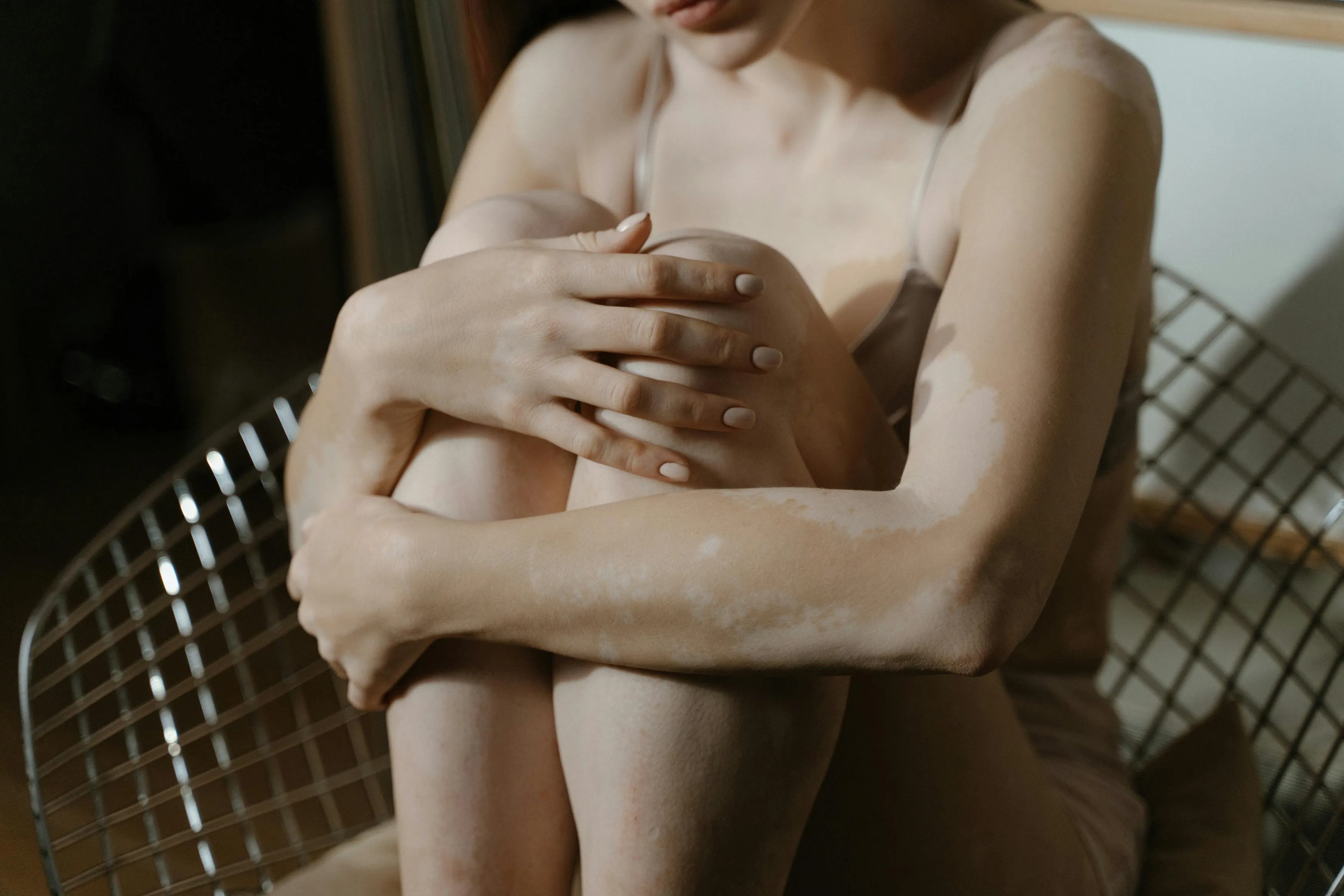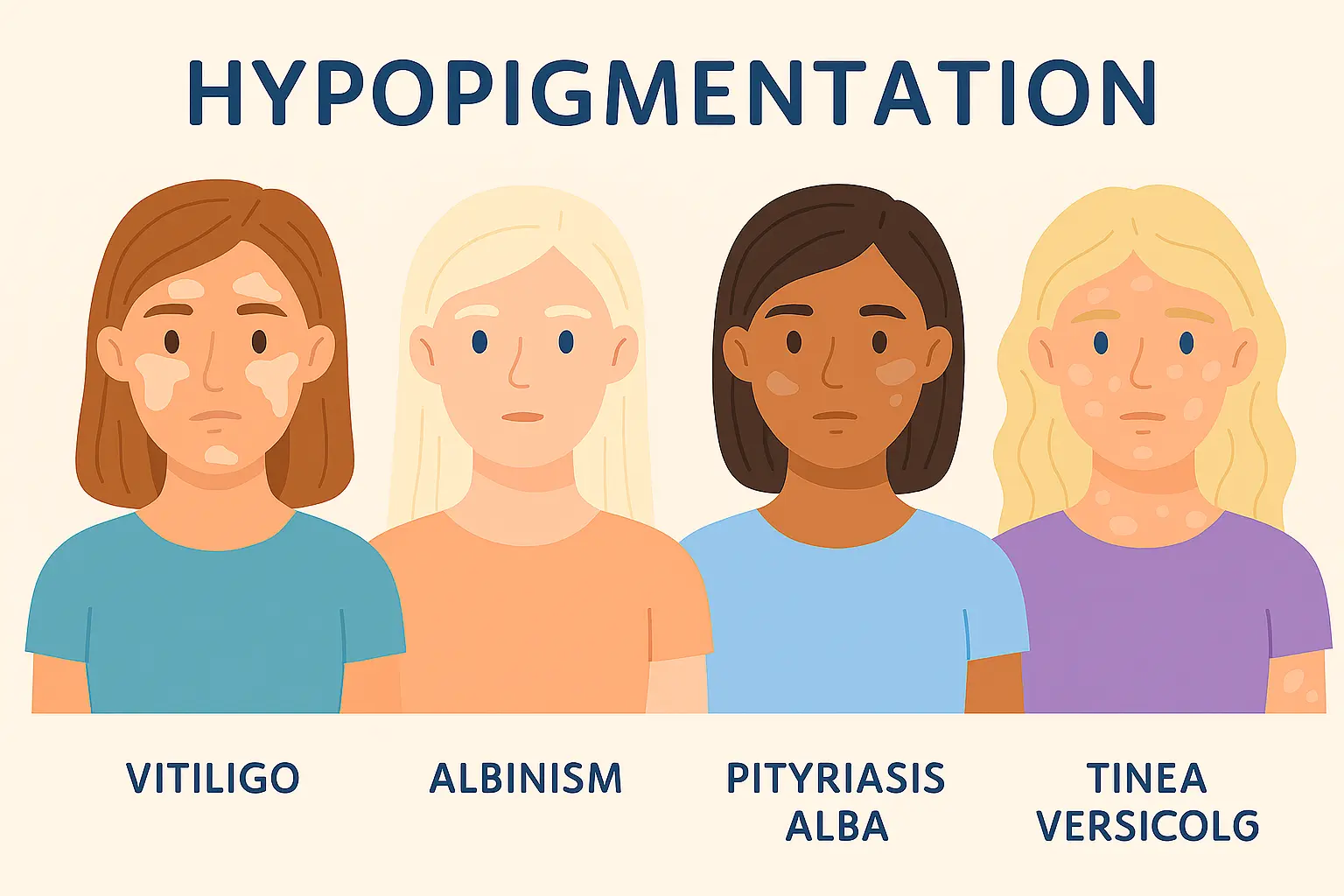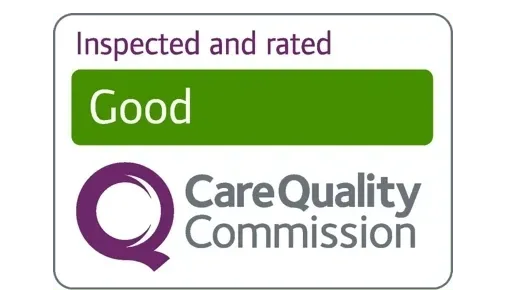What Is Hypopigmentation?
Hypopigmentation refers to lighter patches of skin caused by a reduction or complete absence of melanin, the pigment responsible for your natural skin color. This occurs when melanocytes (the cells that produce melanin) are damaged or stop functioning. Common triggers for hypopigmentation include:
The loss of pigment can be triggered by several common factors:
- UV Exposure While the sun’s ultraviolet (UV) light is a common cause of hyperpigmentation, it can also contribute to hypopigmentation if it damages melanocytes (the pigment-producing cells), although this is less common.
- Inflammation/Injury Damage from conditions like acne, eczema, cuts, or burns can lead to a "scar" of pigment being left behind.
- Hormones Hormonal fluctuations (such as those during pregnancy or from certain medications) can occasionally lead to pigment loss, though this is less common.
Unlike hyperpigmentation (darkening of the skin), hypopigmentation results in a visible loss of colour, which many patients seek treatment for to achieve a uniform skin tone.

Types of Hypopigmentation We Treat
As Harley Street specialists, we diagnose and treat both autoimmune and acquired forms of pigment loss, including:
- Vitiligo An autoimmune disorder resulting in well-defined white patches, which may spread across different areas of the body. While vitiligo is a chronic condition, treatments can help stabilize and restore pigment over time.
- Post-Inflammatory Hypopigmentation (PIH) Lighter patches left behind after the skin heals from trauma, burns, laser treatments, or skin inflammation.
- Tinea Versicolor A fungal infection that causes small, scaly, lighter patches, often asymmetrical, typically found on the chest, back, or shoulders.
- Pityriasis Alba A condition characterized by pale, often dry patches, typically in children and young adults. It is often associated with eczema or dry skin and may resolve on its own with moisturizing care, though some patients may benefit from topical treatments.
Learn more about Vitiligo treatment in London.

Our Personalised Treatment Options
Treatment at Revitalise London is entirely based on the diagnosis and extent of pigment loss. Our experts use evidence-based therapies focused on repigmentation (restoring colour) and skin health:
- Targeted Topical Medications These include prescribed corticosteroids to suppress the immune response or calcineurin inhibitors (e.g., tacrolimus) for sensitive areas, as well as advanced non-steroidal agents aimed at stimulating pigment return.
- Advanced Light & Laser Therapy We use specific wavelengths, including narrowband UVB (the gold standard for vitiligo) and excimer laser, to stimulate melanocytes and encourage pigment return in affected areas.
- Medical Microneedling Typically combined with specialized peptide and vitamin serums, microneedling enhances the skin’s ability to regenerate and accept new pigment, especially useful for post-inflammatory hypopigmentation (such as scarring) and other acquired pigment loss.
- Surgical Options (Grafting) For very stable, localized areas of Vitiligo, our dermatologists may discuss melanocyte or skin grafting procedures.
- Camouflage & Support Professional advice on medical-grade camouflage makeup and long-term skincare protocols for maintenance and sun protection.
All treatments are tailored by our dermatologists to your specific skin type and condition.
Our 4-Step Hypopigmentation Care Pathway
For patients experiencing loss of skin colour, including vitiligo, we provide a tailored journey:
- In-Depth Diagnostic Review
Assess type of hypopigmentation, rule out underlying causes, and carry out specialist imaging where needed. - Individualised Care Plan
May involve topical treatments, light therapy, microneedling, or camouflage support depending on severity. - Specialist Treatments
Delivered by experienced dermatologists to stimulate repigmentation and restore balance. - Long-Term Support
Ongoing monitoring, lifestyle guidance, and emotional support for managing chronic conditions like vitiligo, which may require adjustments to the treatment plan over time.
The treatment plan will be personalized to address the specific type of hypopigmentation and the underlying cause, such as autoimmune conditions like vitiligo or post-inflammatory pigment loss.
100% Satisfaction Guarantee
If you're not completely satisfied with your treatment results within 30 days, we'll provide a refund or free re-treatment. Your satisfaction is our priority.
Licensed & Insured • Risk-Free Treatment
Why Choose Revitalise London for Hypopigmentation?
We combine clinical excellence with a patient-first approach. Here's why hundreds trust us:
Nathalie Emmanuel
Actress - Game of Thrones Star
Had a wonderful experience with Dr Ken and his staff with my forehead lipoma removal. Thorough in planning before the procedure and so far, l've had a great experience with aftercare. When I had any questions there was always someone available to answer them.

Our Medical Team
Meet the experienced professionals who will provide your care
Our Accreditations
Trusted by healthcare regulators and professional bodies for maintaining the highest standards of medical care and patient safety.



🛡️ Regulated & Certified Healthcare
All treatments are performed by GMC registered doctors in our CQC regulated clinic, ensuring the highest standards of safety and care.
FAQs About Hypopigmentation
It depends on the cause — some types, like post-inflammatory hypopigmentation, can fade with treatment. Others, such as vitiligo, often require long-term management to control pigment loss.
Yes, certain types like vitiligo can gradually spread over time. Early treatment may help slow progression and improve skin appearance.
Yes, hypopigmentation treatments are safe for all skin tones when properly customized. Our dermatologists carefully tailor care plans, especially for darker complexions.
Some mild cases improve within a few weeks with consistent treatment. Autoimmune-related pigment loss may take longer and often requires ongoing therapy.
Hypopigmentation can result from skin damage, inflammation, infections, or autoimmune conditions like vitiligo. It occurs when melanin production is reduced or absent in certain areas.
Yes, sun exposure can make hypopigmented areas more noticeable by darkening the surrounding skin. Using sunscreen daily helps protect your skin and prevent contrast.





